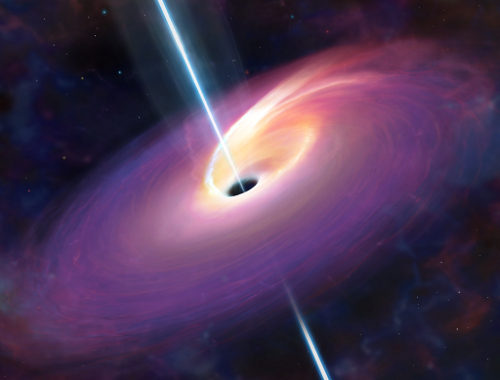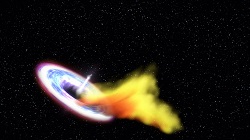An international team of astrophysicists has established that supermassive black holes behave like small stellar black holes. They made their discovery by observing a supermassive black hole that has torn apart a star, causing a surge of gas towards it. Normally such a change in the gas flow takes too long to detect. But this time the transition from a steady flow to a surge of gas happened abruptly, enabling the researchers to detect a jet blasting from the supermassive black hole. This neatly fits the pattern found near small black holes. The results appear 26 November in Science.

Gas flows are often found nearby black holes. Many supermassive black holes are fed by a steady diet of gas, leading to gas flows that live for millions of years and change little on a human timescale. But the newly discovered black hole gas flow behaved very differently: the observations show that following the injection of gas, the supermassive black hole produced a short but spectacular radio flare. The astrophysicists discovered that this radio flare originates from a jet blasting matter from the supermassive black hole at nearly the speed of light. They also observed a burst of X-rays and optical light. This follows the pattern found in small stellar-mass black holes.
Rapid response
The discovery of this radio flare was made possible by a rapid observational response after the stellar disruption (known as ASAS-SN-14li) was announced in December 2014. “Previous efforts to find evidence for these escaping jets, including my own, were too late to the game,” says Sjoert van Velzen, postdoctoral fellow at Johns Hopkins University, lead-author of the Science paper. Co-author Thomas Wevers (Radboud University and SRON) adds: “These earlier attempts all involved events that happened far away, while we now were the first to get front row seats for the action.” In this branch of astronomy, the front row means a distance of 300 million light years, while the previous observations were based on events at least three times farther away.
Matryoshka dolls

The observed jet was anticipated by the so-called scale-invariant model of accretion, also known as the Matryoshka-doll theory of astrophysics. It predicts that all compact astrophysical objects that accrete matter (e.g. from stellar-mass black holes to super-massive black holes) behave and look the same after a simple correction based on solely the mass of the object. In other words, the larger Matryoshka doll (a supermassive black hole, millions to billions times as massive as the Sun) is just a scaled-up version of the smaller doll (a stellar-mass black hole that has a mass of around ten times that of the Sun). Since stellar-mass black holes consistently produce a radio-emitting jet when they are supplied with a large amount of gas, the theory predicts that supermassive black holes should do the same when they swallow a star.
“I always liked the elegant nature of the scale-invariant theory,” says co-author Peter Jonker (SRON/Radboud Universiteit). “But previous observations never found evidence for the jet it predicted. Our new findings suggest that this new type of jet could indeed be common. Previous observations were simply not sensitive enough to detect them.” Thus, the study concludes by hypothesizing that every stellar disruption leads to a radio flare similar to the one just discovered. Finding more of these rare events may further improve our understanding of the processes that allow black holes to launch such spectacular jets.
More information
For their observations the astrophysicists used the AMI radio telescope array, the Westerbork radio telescope array and the Swift X-ray satellite. The paper A radio jet from the optical and X-ray bright stellar tidal disruption flare ASASSN-14li will be published online 26 November in Science. Authors are: Sjoert van Velzen (Johns Hopkins University), Thomas Wevers (Radboud University/SRON), Peter Jonker (SRON/Radboud University), G. E. Anderson (University of Oxford, Curtin University), N. C. Stone en B. D. Metzger (University of Columbia), M. Fraser, S. T. Hodgkin en H. C. Campbell (University of Cambridge), A. J. van der Horst (George Washington University), T. D. Staley (University of Oxford), A. J. Mendez (Johns Hopkins University), J. C. A. Miller-Jones (Curtin University), en R. P. Fender (University of Oxford).


